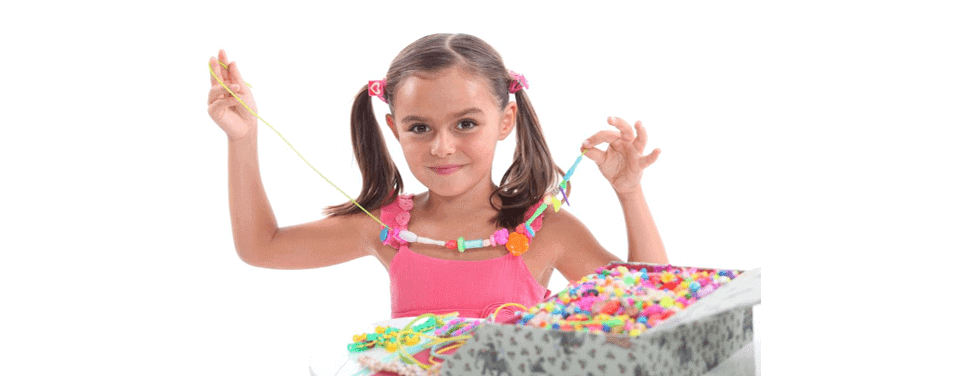3 Therapeutic Benefits of Beading for Children

The art of beading is about so much more than creating beautiful pieces of jewelry or home décor. In addition to being an enjoyable hobby that is appropriate for people of all ages, beading has therapeutic benefits. Bead therapy is used in hospitals, clinics and other settings to help both kids and adults in numerous ways.

While crafts like beading are good for just about everyone, they can be especially beneficial for children with special needs. Whether it is a child who needs to spend an extended period of time in the hospital, a kid who is struggling to learn to write because they have trouble with fine motor skills or a little boy or girl who is struggling in school due to symptoms of ADHD, autism, etc. beading can help. Keep reading to discover some of the therapeutic benefits of beading.
Beading Improves Fine Motor Skills
Many children, particularly those with special needs, struggle with fine motor skills. As a result, it is extremely important to engage them in activities that help them develop and strengthen these vital skills. Beading works well for this because it is a project that kids actually enjoy participating in, and it goes a long way toward improving fine motor skills.
There are a few different ways to use beads for this purpose. Stringing beads is an excellent option. Provide beads with large holes and help the child thread them onto a string or a piece of elastic. Doing so improves their skills and enables them to create jewelry that they can wear or share with their loved ones.

Beads can also be placed in sensory boxes. Place beads of various sizes inside a large plastic container. Consider using gemstone beads in various colors and textures and encouraging your child to explore them with their hands. As they roll the beads between their fingers to see what they feel like, they will be building their fine motor skills without even realizing it.
It also works well to use something like rice as a base and then add other objects for kids to sort out. Encourage your child to remove the beads one by one from the box. Or ask them to only take out one type, color or size of bead. Once they are able to do so using their fingers, encourage them to do the same thing using silverware or a pair of tongs. Get creative! All of these activities improve fine motor skills, so there is really no “wrong” way to go about using sensory boxes to help your kids.
Keep in mind that some children have dumped sensory boxes out onto the floor, creating a mess that needs to be swept or vacuumed up. Additionally, small items like beads can be a choking hazard. Adult supervision is recommended to prevent spills and choking incidents that can occur with the use of sensory bins.
Beading Decreases Illness-Related Stress
Illness-related stress doesn’t just impact adults. It affects kids, too. No child wants to be suffering from an illness or a condition that prevents them from being able to run and play like other kids. While they may not fully understand their diagnosis or exactly why they are unable to do the things they want to do, they can feel the stress and anxiety that comes from illnesses and disorders.
Beading is a quiet activity that nearly everyone can do. It doesn’t really require any special supplies, and it can be done virtually anywhere. When working with beads and focusing on stringing them or using them to create patterns, it’s easy to escape from stress and anxiety for a little while. Even kids can use beading as a means of escaping from their current problems. It’s also an activity that is enjoyable for everyone, so it’s something that they can do with their friends, siblings or other family members.
Learning a craft, like beading, is a great coping strategy, too. Older kids with special needs may struggle with accepting their disabilities. Picking up a hobby like beading can give them a sense of purpose and enable them to spend their time doing something that they truly enjoy. Crafting, in general, can be a great coping mechanism for people of all ages, so encouraging your child to bead is a very positive thing.
Beading Improves Cognitive Skills
Crafts like beading are also great for special needs kids because they improves cognitive skills. If you have a toddler, you can start out by using beads to help your little one learn how to count, identify shapes or sort by color and size. You can also use beads to teach your child math skills–like addition and subtraction–and pattern-making or memorization skills. If you invest in high-quality gemstone beads, you can even use them as part of your science lessons by helping your child understand the different properties of various types of natural gemstones and how those properties make them look the way they do.
Please supervise all beading activities due to choking hazards.
Conclusion
As a parent, seeing your child struggle for any reason is incredibly difficult, and you want to do anything you can to enrich their lives and ensure their happiness. Encouraging them to work on arts and crafts projects is a great way to help them develop and strengthen vital skills, cope with their illness and pass the time in an enjoyable way.
Beading offers therapeutic benefits for children of all ages. Whether you use beads to help a toddler learn how to count and build fine motor skills or you encourage an older child to learn how to bead as a means of coping with their illness or creating a sense of purpose for themselves, this hobby is one that can make a real difference in a child’s life. Experiment with using beads in various ways to find the option that works best for the child in your life.
Thank you for visiting educationandbehavior.com-a free resource for parents, educators, therapists and counselors! Browse our topics from our menu button at the top of the page.
You May Also Like: Five Fun Scientific Art Projects for Kids

Rachel Wise is the author and founder of Education and Behavior. Rachel created Education and Behavior in 2014 for adults to have an easy way to access research-based information to support children in the areas of learning, behavior, and social-emotional development. As a survivor of abuse, neglect, and bullying, Rachel slipped through the cracks of her school and community. Education and Behavior hopes to play a role in preventing that from happening to other children. Rachel is also the author of Building Confidence and Improving Behavior in Children: A Guide for Parents and Teachers.
“Children do best when there is consistency within and across settings (i.e., home, school, community). Education and Behavior allows us to maintain that consistency.”








